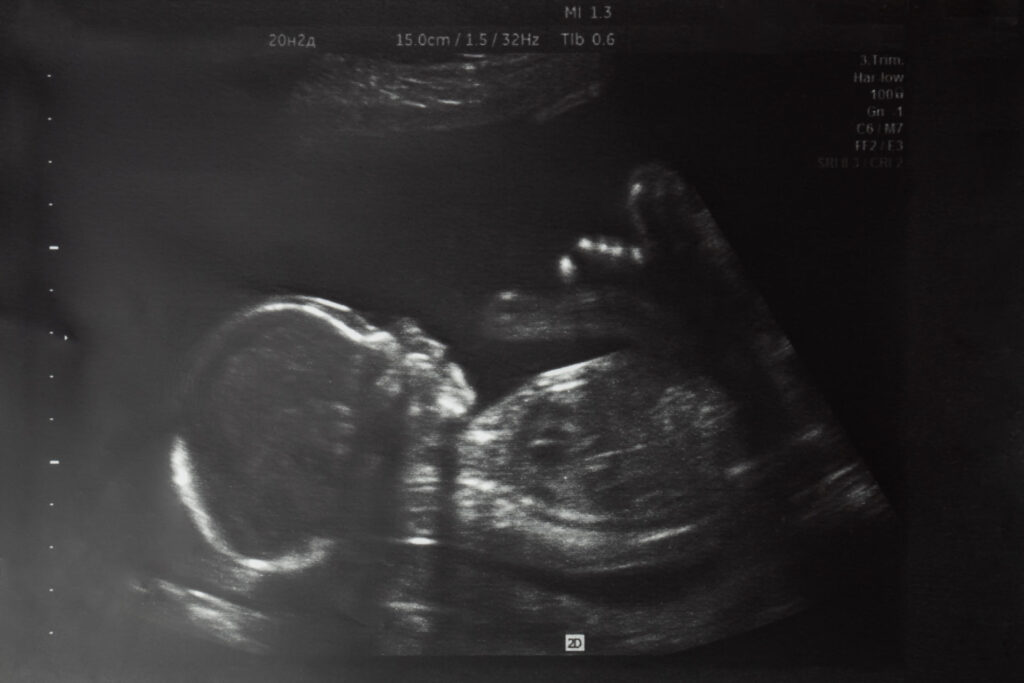20 Week Ultrasound – What to Expect at the Visit
The 20-Week Ultrasound, a.k.a. the 20-week anatomy scan, is a screening test in mid-pregnancy to confirm that your baby is growing normally. This detailed ultrasound will take anywhere from 45 minutes to an hour and is usually done in the 2nd trimester between 18-22 weeks gestation.
Ultrasound technicians find and measure the baby’s internal organs, baby’s growth and check for any obvious problems like spina bifida, anencephaly, cleft lip and heart defects. The technician will also check to see if there is sufficient amniotic fluid, the location of the placenta and that the umbilical cord has three vessels.
Your placenta will also be assessed for risk of placenta previa.
During the 19-22 week ultrasound, you will get to hear your baby’s heartbeat. A normal heart rate range at this stage of gestation is between 120-180 beats per minute.
After you leave, a specialist will look at the anatomy scan and let you know if they find any possible problems.
Some parents-to-be would rather know ahead of time if their baby has any chromosomal abnormalities or abnormalities or markers for potential genetic disorders.
The most common reason people want to get an ultrasound is to find out the sex of the baby.
Is the 20 Week Ultrasound (Anatomy Scan) Safe?
Some pregnant women choose not to have an ultrasound at all. Unless one is medically indicated (for example, you are measuring small), they figure the possible risks outweigh the benefits.
Ultrasound technology and the effect it has on a growing fetus is not well understood. We know that the ultrasound waves cause cavitation (pitting) in cells and that babies are generally bothered by the procedure.
Ultrasound technicians often have trouble getting a good image because of the baby’s position, or the baby is moving away or putting his/her hands in front of his/her face.
The American Congress of Obstetricians and Gynecologists (ACOG) states that:
Currently, there is no reliable evidence that ultrasound is harmful to a developing fetus. No links have been found between ultrasound and birth defects, childhood cancer, or developmental problems later in life. However, it is possible that effects could be identified in the future. For this reason, it is recommended that ultrasound exams be performed only for medical reasons by qualified health care providers.
The FDA recommends against extra “keepsake” (3d or 4d ultrasounds) ultrasound photos or home doppler use, saying:
The long-term effects of tissue heating and cavitation are not known. Therefore, ultrasound scans should be done only when there is a medical need, based on a prescription, and performed by appropriately-trained operators.
What Will The 20-week Baby Ultrasound Images Show?
Most of the ultra sound images on the screen are relatively difficult to interpret for the untrained eye. It can look like a lot of gray, white and grayer smudges.
The technician is looking for organs and outlines; the technician can point things out to you if you ask.
Most of the time, you can find out the baby’s gender. Sometimes they will alter your due date based on the 20-week scan, but dating is notoriously unreliable this late in pregnancy. It’s also difficult to tell where the cord is during pregnancy on a scan, but sometimes they will check and tell you.
You may certainly be able to see the baby’s head and profile and may be able to see the baby’s fingers and toes on the screen.

What Should I Wear to the Pregnancy Ultrasound?
Dress comfortably and wear pants or a skirt that you can easily unbutton and pull down with a shirt you can easily lift up when you go for your 20 week anatomy scan ultrasound appointment.
Typically you keep all your clothes on during a pregnancy ultrasound, but expose the belly, down closer to your pubic bone. Especially if you get another sonogram later in pregnancy, they may need to do the imaging lower.
Why Isn’t the Technician Talking to Me?
The technician’s job can be tricky, especially if your little one is moving a lot. You don’t want to be under the wand forever, so he/she may also be trying to work quickly.
Ultrasound techs are people, too, so if you got a quiet one, you may have to ask to be more involved. It’s not his/her job to interpret the findings.
The technician is not supposed to tell you that everything is fine or that there are problems because they are not trained to determine that. Even so, a friendly one will chat with you and point out the baby’s body parts. These types of scans will be medically reviewed by a doctor.
Can I See the Ultrasound Screen?
While the tech is taking measurements, she may need to face the screen away from you for some time. You can definitely ask to see what they see and get the screen turned toward you at intervals.
The images are hard for most of us to interpret, but a good and kind tech will point things out. If not, you should just ask. “What’s that line of little white spots?” (most likely the baby’s spine) or “where’s the baby’s hands?” If you want to see, just ask.
When Can I Find Out My Baby’s Sex?
Most of the time, the technician can find the baby’s gender by seeing the genitals and tell you if it’s a boy or girl. He/she’s looking for three lines to indicate a baby girl and little appendage for a baby boy.
The umbilical cord can look like a penis, and especially if baby is moving a lot, it’s not always perfect, even in these modern times. People do sometimes get a surprise on birth day.
How Does Pregnancy Ultrasound Work?
High-frequency sound waves that bounce off the baby and your other insides get pieced together to form an image of the baby on the screen.
You lay down and expose your belly. The ultrasound technician puts some cold gel on the transducer (wand) and then moves it slowly but almost constantly around your belly.
The baby feels the ultrasound waves and doesn’t like them, so don’t be surprised if it’s hard to get the right angle or see what you want to see because baby is moving or putting his/her hands in the way.
Should I be Concerned if Any Abnormalities are Found During the Ultrasounds?
Ultrasound scans, when used alone, are not the most reliable method for making an accurate diagnosis. For instance, sometimes your baby is not in a good position to get detailed enough images during the scan.
If the doctor suspects an abnormality from your ultrasound, he/she may recommend additional tests to get a more detailed look at how your baby is developing.
How Should I Prepare for the 20 Week Pregnancy Ultrasound?
There’s not much you need to do when going in for a pregnancy ultrasound. Wear comfortable clothes. Sometimes it helps if you have a full bladder because it raises baby more fully out of your pelvis to simplify imaging.
You will also want to decide in advance if you want to find out your baby’s sex or if you’d prefer to wait and be surprised with a boy or girl.
Finally, plan to bring dad or a support person along – the process can be a bit stressful at times and it helps to have someone by your side. Plus they will get to share in the joy of seeing baby’s face and maybe even find out if they will be welcoming a son or daughter in a few months.
Planning for Childbirth
The 2nd trimester of pregnancy is usually the time that most women feel their best during pregnancy. It’s also the a great time to begin planning for your birth! If you haven’t written a birth plan, now is a good time to download one.
Here is a link to a free birth plan template with a video series. It is also a perfect time to take a good, evidence-based childbirth class.
Disclaimer: Pregnancy by Design’s information is not a substitute for professional medical advice or treatment. Always ask your health care provider about any concerns you may have.
Cited Research
American College of Obstetricians and Gynecologists (2017). Ultrasound Exams. Retrieved from https://www.acog.org/Patients/FAQs/Ultrasound-Exams.
Food and Drug Administration. (2014). Avoid Fetal “Keepsake” Images, Heartbeat Monitors. Retrieved from https://www.fda.gov/consumers/consumer-updates/avoid-fetal-keepsake-images-heartbeat-monitors.



 A Guide to the First 48 hours After Birth: Newborn Care
A Guide to the First 48 hours After Birth: Newborn Care






Leave a Reply